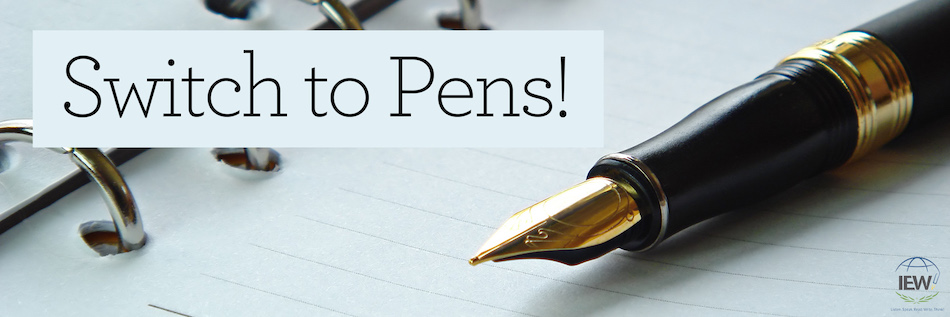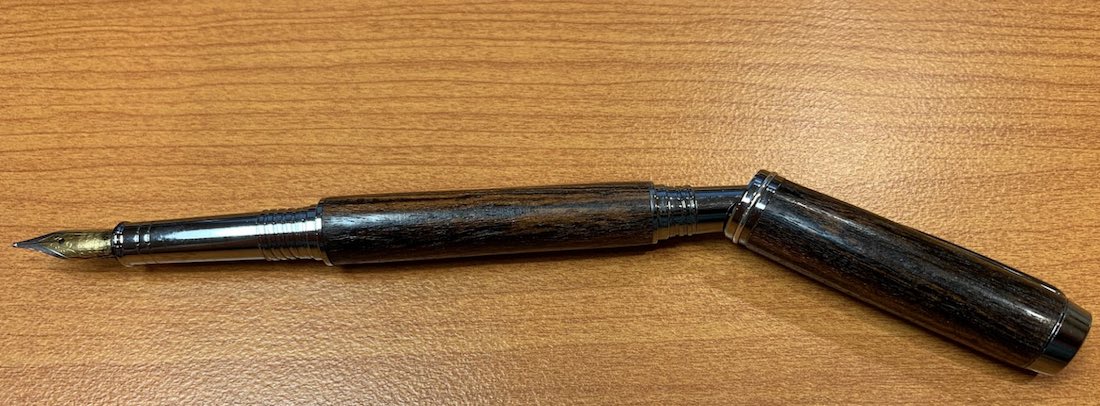
Several years ago Andrew Pudewa published an article entitled “Convert ... to Pens!” In doing so, he flipped on its end the conventional thinking of writing the first draft in pencil and the final draft in pen. But other than stating that the pen should be of “a high quality, roller tip dark ink,” Andrew didn’t expand much more about the instrument itself. So what characteristics of a good pen should we be looking for?
I considered this question a great deal when my kids were younger. In this blog post I’d like to introduce you to some wonderful pencil alternatives out there that I’ve discovered. If you are one of those who waits until the last minute to pick up the kids’ school supplies, you can simply add one or two of these pen suggestions to your shopping list. If you’re the “eager beaver” of the school supply world, no worries. You now have the perfect excuse to head back out to your favorite office supply shop.
All pens are not the same. Nor do all pens work for everybody. Young writers, dysgraphics, lefties, and people with variant grips all respond differently to different pens. But it is worth it to take the time to find the writing instrument that works the best for your students. With that in mind I will share some of my personal favorites as well as pens I recommend for students who may have some more unique needs. Most of these pens are affordable, and many even offer refills, which keeps the price point lower over time.
- Fountain Pens
I’ll start with my personal favorite. As a leftie I never thought I would be able to use a fountain pen. I worried that the way I held my hand would cause ink smudging. Not so! By selecting a pen with a fine line and choosing a drier ink, I’ve had much less smudging than I’ve ever experienced with a ballpoint. Since I first started using fountain pens more than five years ago, I’ve begun giving them as gifts to some of my students. My favorite affordable pen to gift is the Platinum Preppy, and it comes in a fun palette of colors. The ink is water-based, not oil-based like ballpoints use. This means it dries faster. Fountain pens can help students who have dysgraphia because the nib has very little drag across the paper but still supplies helpful feedback. Notably, it only requires a light touch to apply ink to the page. This reduces hand fatigue. My son who has struggled with dysgraphia found that he was able to improve his writing a great deal with a fountain pen whereas a ballpoint was difficult for him to use. Offered in a wide array of colors, fountain pens make fun incentive gifts for students. Another pen that I personally enjoy using that doesn’t cost an arm and a leg is the Pilot Metropolitan. The nib is smooth, and the pen feels great in my hand. Cons: Students who have grip differences, such as a dyslexic overwrap grip, may find them frustrating or even impossible to use. If that’s your student’s case, I recommend one of the other alternatives I mention later. Also, they are more prone to bleeding through standard notebook paper. I typically select notebooks that are fountain pen friendly for this reason.
- Rollerball Pens
Rollerball pens mimic ballpoint pens, but again, the surface of the pen flows more evenly and smoothly than many ballpoints. They write with a fine line. Additionally, the ink in the pens is less viscous than ballpoint pens, more like the water-based inks of fountain pens, so they have a very nice laydown and are less prone to leaving gaps or blobs on the page. This makes the pen more enjoyable to write with as well. Students who struggle with a fountain pen are likely to find rollerball pens easier and more pleasant to use. Not only that, but you can order replacement cartridges for most rollerballs. Cons: This type of pen and ink may be a little more prone to smudging. Also, the pens go through ink more frequently than ballpoints do.
- Gel Pens
An intermediary between a rollerball and a ballpoint, gel pens have ink that’s still water-based, but it is a little thicker than a rollerball’s. The colors are extremely vibrant, which can motivate students who enjoy the color of the ink. Because the ink is a little thicker, there may be slightly more friction of the ball of the pen against the paper, which may make the writing experience more or less enjoyable. It depends upon the student. The ink is laid down on the paper with a thicker line than a rollerball, but it still offers a smooth writing experience. Cons: Occasionally gel pens will skip or clump although this happens less frequently than with ballpoints. Also, as with rollerballs, gel pens tend to go through ink more quickly than ballpoints.
I was interested to learn what pens Andrew Pudewa enjoys writing with, and he shared three recommendations. Notably, all three are fountain pens. His favorite is the Parker Sonnet with a medium nib. He’s had it for around eight years and uses it daily. Another one of his favorites was made by a homeschool teenager with a pen-making business in New York. Andrew bought it from him at a convention. He likes that it is nice and heavy and writes well. His other favorite pen is truly luxurious and was a gift—a Montblanc.

One of Andrew’s favorite fountain pens, designed by a homeschooled student.
Most office supply stores offer rollerball and gel pens, but not all offer fountain pens. If you can’t find a fountain pen locally, it’s worth it to try one out by ordering over the Internet. It may take some time to find a pen that works best for each of your students. Be patient and persist! When you find the right one, your student will thank you. And it’s quite possible that as soon as he does, he’ll run off with it to start writing, hopefully on his latest IEW assignment!
|
Jennifer Mauser has always loved reading and writing and received a B.A. in English from the University of Kansas in 1991. Once she and her husband had children, they decided to homeschool, and she put all her training to use in the home. In addition to homeschooling her children, Jennifer teaches IEW classes out of her home, coaches budding writers via email, and tutors students who struggle with dyslexia. |

